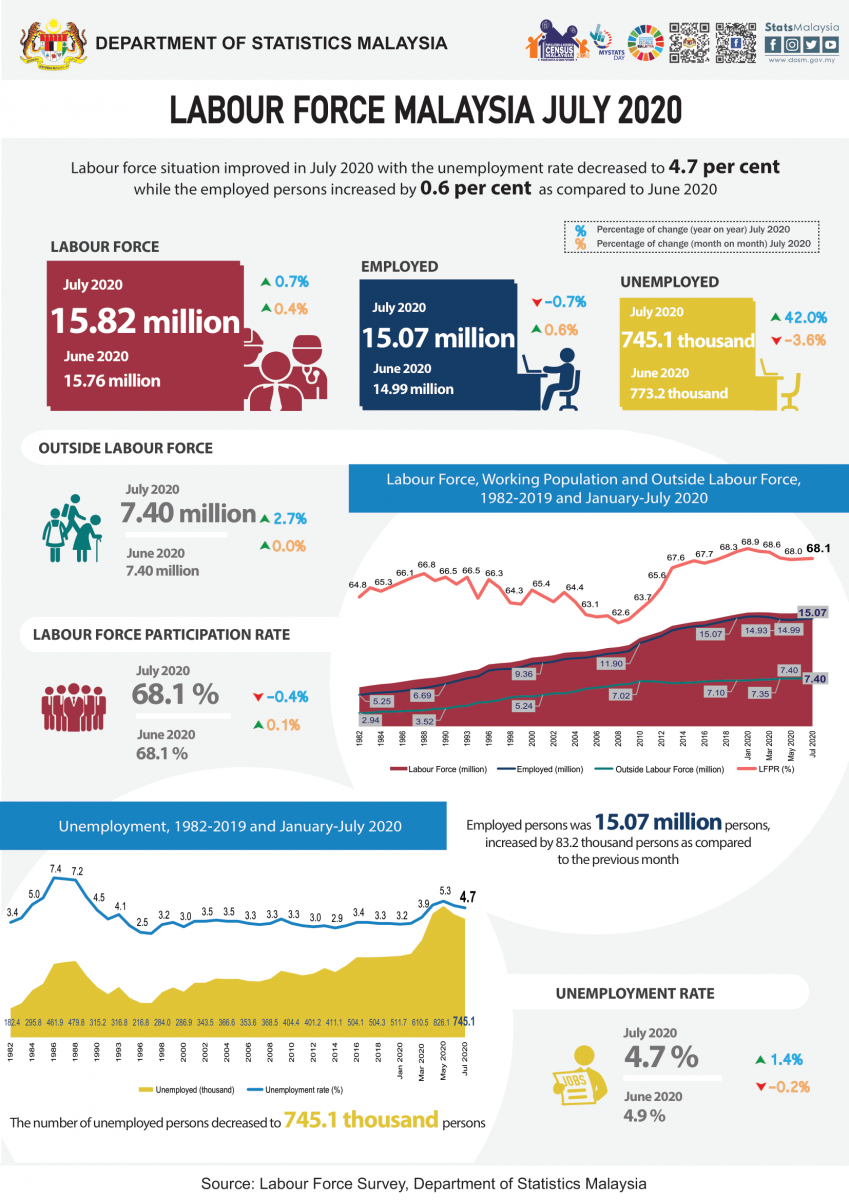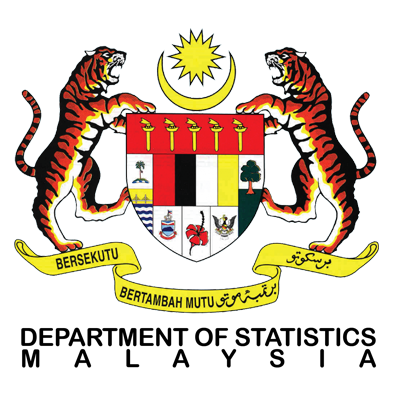Labour Force
- Home
- Statistics
- Labour Market
- Labour Market Information
- Labour Force
Key Statistics of Labour Force in Malaysia, July 2020
Key Statistics of Labour Force in Malaysia, June 2020 7 August 2020
Principal Statistics of Labour Force, Malaysia, Second Quarter (Q2) 2020 14 July 2020
Key Statistics of Labour Force in Malaysia, May 2020 15 June 2020
Key Statistics of Labour Force in Malaysia, April 2020 8 May 2020
Key Statistics of Labour Force in Malaysia, March 2020 8 May 2020
Principal Statistics of Labour Force, Malaysia, First Quarter (Q1) 2020 Show all release archives
Overview


KEY REVIEWS
- In July 2020, the number of employed persons continued to grow by 0.6 per cent month-on-month after recording a growth of 0.7 per cent in June 2020. The number of employed persons went up to 15.07 million persons. The employment-to-population ratio increased to 64.9 per cent in July 2020.
-
Most economic sectors posted an increase in employed persons since June 2020 as recovery Movement Control Order (RMCO) took effect. The significant increase was in the Services sector mainly in accommodation, food & beverages and transport & storage activities. There was also slight increase in art, entertainment & recreational activities.
-
In July 2020, the number of own-account workers decreased by 36.9 thousand month-on-month to 2.38 million persons in July 2020. This group which continued to decline since April 2020, comprised mostly of daily wage earners working in farmers’ markets, night markets and stalls; freelancers; as well as smallholders. They were reported to be the most affected group due to COVID-19 pandemic.
-
Unemployment rate continued to fall in July 2020 to 4.7 per cent after recording 4.9 per cent in June 2020. The number of unemployed persons fell by 28.2 thousand to 745.1 thousand persons.
-
As the permission to operate extended to more sectors including tourism, education, entertainment & recreational activities, the total labour force increased by 55.0 thousand persons to 15.82 million persons compared to June 2020. The labour force participation rate (LFPR) in July 2020 remained at 68.1 per cent.
-
The number of outside labour force increased slightly by 0.02 per cent (+1.3 thousand persons) to 7.40 million persons. The largest share of outside labour force was due to housework/ family responsibility followed by schooling.
-
As the pandemic continues to change the economic landscape, the business models continued to be reinvented; subsequently causing shift in job trends. In relation to this, the government initiatives on strategic investments may become a catalyst of innovation to encourage the use of technology in cross-sectoral businesses.
LABOUR FORCE SITUATION CONTINUED TO IMPROVE DURING THE RMCO PHASE
The RMCO implemented since 10 June 2020 had allowed more economic sectors to resume. As the country move to a recovery stage with low number of new COVID-19 cases in July 2020, the education sector was allowed to reopen for students to return to schools and learning institutions. Hence, in mid July 2020, the education sector began reopening in stages resulting in positive impact on related activities such as school bus services, school canteens and tuition centres. In addition, university and college students were allowed to return to their campuses and higher learning institutions are expected to be fully reopen by October 2020. At the same time, childcare centres started to operate early July 2020, allowing more parents to return to work.
During the month, it was also observed that there were more travelling activities following the Aidiladha and the school holiday. Many took the opportunity to travel within the country after tourism activities came to a halt in the previous stage of the MCO. Subsequently, there were more demand in accommodation, food & beverages and entertainment & arts, recreational services which encourage businesses to retain or even to increase job opportunities. In other words, the resumption of economic activities had resulted in revival of the labour force situation.
The Labour Force Report for July 2020 describes the labour supply situation as the country entered the second month of RMCO. The report will elaborate on the year-on-year changes in addition to the short-term changes from the previous month to examine the immediate effects of the MCO to contain the spread of COVID-19. Users are advised to interpret the monthly statistics with caution since they are non-seasonally adjusted.
Employed persons continued to increase in July
In July 2020, the number of employed persons continued to grow by 0.6 per cent month-on-month after recording a growth of 0.7 per cent in June 2020. After three consecutive months registering employed persons below 15 million, the number went up to 15.07 million persons. On the contrary, employed persons declined by 0.7 per cent year-on-year as against July 2019.
The employment-to-population ratio increased to 64.9 per cent in July 2020 from 64.7 per cent in the previous month, indicating the ability of an economy to create employment. Year-on-year, the employment-to-population ratio dropped 1.3 percentage points from 66.3 per cent in July 2019. [Chart 1]
Chart 1: Employed persons and employment-to-population ratio, January 2018 - July 2020

Most economic sectors posted an increase in employed persons since June 2020 as the first month of RMCO took effect. The significant increase was in the Services sector mainly in accommodation, food & beverages and transport & storage activities. There was also slight increase in art, entertainment & recreational activities.
In term of status in employment, own-account workers decreased by 36.9 thousand month-on-month to 2.38 million persons in July 2020. This group which continued to decline since April 2020, comprised mostly of daily wage earners working in farmers’ markets, night markets and stalls; freelancers; as well as smallholders. They were the most affected group due to COVID-19 pandemic. [Chart 2]
Chart 2: Employed person by status in employment, June and July 2020

During the month, there were only 104.3 thousand employed persons who were temporarily not working as compared to 908.9 thousand persons in June 2020. This group of persons, who were most likely not able to work was not categorised as unemployed as they had work to return to. The decline in the total number of employed persons who were temporarily not working among others was due to the positive effect of the resumption of the education sector such as schools, pre-schools, childcare centres, tuition centres and private colleges as well as other activities namely cafeterias/ canteens.
Unemployment rate continues to fall
Unemployment rate continues to fall in July 2020 to 4.7 per cent after recording 4.9 per cent in June 2020. During the same period, the number of unemployed persons decreased by 28.2 thousand to 745.1 thousand persons (June 2020: 773.2 thousand persons). Year-on-year, the number of unemployed persons increased by 220.3 thousand persons as against July 2019 (524.8 thousand persons). [Chart 3]
Chart 3: Unemployed persons and unemployment rate, 1982 - 2019 and January - July 2020

More than half of the unemployed persons were actively unemployed, increased from 76.8 per cent to 83.2 percent in July 2020. The actively unemployed for less than three months increased by 2.9 percent (+8.7 thousand persons) to 307.4 thousand persons as compared to the previous month (June 2020: 298.7 thousand persons). In the meantime, a total of 57.1 thousand persons were in long-term unemployment[1] of more than a year, posted a share of 9.2 per cent.
Meanwhile, the inactively unemployed or discouraged group whom believed there were no jobs available lessened by 30.3 per cent (-54.3 thousand persons) to 124.9 thousand persons in July 2020. [Chart 4]
Chart 4: Unemployed category and duration of unemployment, June and July 2020

The unemployment rate for adult aged 25 years and over was 3.2 per cent, declined 0.1 percentage points as against June 2020 which was 3.3 per cent. Meanwhile, the unemployment rate for youth aged 15 to 24 years rose 0.8 percentage points to 13.9 per cent (June 2020: 13.1%). However, the unemployment rate for youth aged 15 to 30 years remained at 9.7 per cent. [Chart 5]
Chart 5: Unemployment rate by selected age groups, 1982 - 2019 and January - July 2020

LFPR remained at 68.1 per cent
As the permission to operate extended to more sectors including tourism, education, entertainment & recreational activities, the total labour force grew by 55.0 thousand persons to 15.82 million persons compared to June 2020. Year-on-year, labour force registered an increase of 113.9 thousand persons (0.7%) from 15.70 million persons (July 2019). The LFPR in July 2020 remained at 68.1 per cent. However, it was lower by 0.4 percentage points as against the same month of the previous year. [Chart 6]
Chart 6: Labour Force and LFPR, 1982 - 2019 and January - July 2020

The male LFPR posted an increase of 0.1 percentage points to 80.4 per cent as against June 2020 (80.3%). During the month, the number of male labour force rose by 42.7 thousand persons to 9.6 million persons. Meanwhile, the female LFPR was unchanged at 55.1 per cent with the number of female labour force increased by 12.3 thousand persons to record 6.2 million persons. Year-on-year comparison, both male and female LFPR dropped 0.4 percentage points from 80.7 per cent and 55.5 per cent respectively. [Chart 7]
Chart 7: Labour Force and LFPR by sex, 1982 - 2019 and January - July 2020

More than 80 per cent of outside labour force due to housework and schooling
In July 2020, outside labour force increased slightly by 0.02 per cent (+1.3 thousand persons) to 7.40 million persons while year-on-year rose 2.7 per cent (+192.1 thousand persons). The largest share of outside labour force was due to housework/ family responsibility with 45.4 per cent, followed by schooling with a share of 38.4 per cent. [Chart 8]
Chart 8: Share of outside labour force by reasons for not seeking work, June and July 2020

GOVERNMENT’S INITIATIVES
Apart from the stimulus packages of PRIHATIN, PRIHATIN Plus and Short-Term Economic Recovery Plan (PENJANA) introduced by the government, an additional of RM5.3 billion was allocated by the government for the Wage Subsidy Programme extension. This package covered wage subsidies, reskilling and upskilling programmes, hiring and training assistance as well as gig economy social protection which led to recovery of the labour market since June 2020.
According to the Ministry of Finance Malaysia, as of 24 July 2020, a total of 7,543 employees gained jobs including 66 persons with disabilities and 963 apprentices through the Hiring Incentive Programme (PenjanaKerjaya). In addition, Wage Subsidy Programme aided over 2.6 million employees as at end of July through an approved allocation of RM8.99 billion to 318,258 employers. Meanwhile, a total of RM6.8 million has been disbursed to Tekun Business Recovery Scheme which would be beneficial to 900 micro, small, and medium enterprises.
LOOKING AHEAD
Malaysia’s economy is showing signs of gradual recovery in the upcoming months, unless there is another spike in COVID-19 cases. As the economic activities reopened continuously coupled with more travelling activity, domestic demand may uplift and subsequently increase jobs opportunities. In line with this, labour market is foreseen to revive as employment picks up its pace while unemployment continues to fall. In the second half of the year, potential labour supply will enter the labour market, particularly new graduates. This would impact the jobseekers as the labour market is becoming more competitive for traditional jobs. Thus, new emerging job opportunities largely driven by technology advancement and automation could be alternatives for the new graduates. Optimistically, the new entrants in the labour market who leverage such opportunities may in turn become job creators for others.
As the pandemic continues to change the economic landscape, the business models continued to be reinvented; subsequently causing shift in job trends. In relation to this, the government initiatives on strategic investments may become a catalyst of innovation to encourage the use of technology in cross-sectoral businesses. Among others, an allocation of RM25 million for the Global Online Workforce (GLOW) Programme which aims to provide training for income generation through an online platform. In addition, the government’s initiatives for reskilling, upskilling and cross-skilling programmes provided by various agencies will give positive impact by preparing future workforce with the most in-demand skills.
TECHNICAL NOTES
This information is derived from the Labour Force Survey (LFS) which was conducted to collect information on the structure and distribution of labour force, employment and unemployment.
The survey population cover persons who live in private living quarters and excludes persons residing in institutions such as hotels, hostels, hospitals, prisons, boarding houses and workers residing in construction work site.
The survey comprises of the economically active and inactive population. To measure the economically active population, the LFS uses the age limit of 15 to 64 years. The economically active population comprises of those employed and unemployed whereas those who are inactive is classified as outside the labour force.
LFS uses the actual status approach, where a person is classified on the basis of his labour force activity during the reference week.
- Labour force refers to those who, during the reference week are in the 15 to 64 years (in completed years at last birthday) and who are either employed or unemployed.
- Employed refers to all persons who, at any time during the reference week worked at least one hour for pay, profit or family gain (as an employer, employee, own-account worker or unpaid family worker). Also considered as employed are persons who did not work during the reference week because of illness, injury, bad weather, leave, labour dispute and social or religious reasons but had a job, farm, enterprise or other family enterprise to return to. Also included are those on temporary lay-off with pay who would definitely be called back to work.
- Unemployed
Unemployed refers to those who do not have a job but are interested to work. There are two groups of unemployed that is the actively unemployed and inactively unemployed.
- Outside Labour Force
All persons not classified as employed or unemployed as stated above are classified as outside labour force. Includes housewives, students (including those going for further studies), retired, disabled persons and those not interested in looking for a job.
- Labour Force Participation Rate
The economic activity of a population depends on the demographic characteristics of that population. The proportion of economically active population, therefore, differs between sub-groups of that population. These variations are measured by specific activity rates termed as labour force participation rate. Labour force participation rate is defined as the ratio of the labour force to the working age population (15 to 64 years), expressed as percentage.
- Unemployment rate is the proportion of unemployed population to the total population in labour force. This rate measures the percentage of unemployed population in the labour force.
Population Benchmarks
Population by characteristics of age group, ethnicity and state were used as benchmarks to produce labour statistics.
Starting with the monthly release of the Principal Statistics of Labour Force, Malaysia, January 2016, the principal statistics of labour is estimated based on the current population estimates as compared to the previous series which used population projections based on the Population and Housing Census of Malaysia, 2010. This rebase is to obtain statistics that is more consistent with current population structure.
Released By:
DEPARTMENT OF STATISTICS, MALAYSIA
11 September 2020
Contact person:
Mohd Yusrizal bin Ab. Razak
Public Relation Officer
Strategic Communication and International Division
Department of Statistics, Malaysia
Tel : +603-8885 7942
Fax : +603-8888 9248
Email : yusrizal.razak[at]dosm.gov.my
Subscribe
Newsletter
Subscribe to our newsletter and stay updated
For interviews, press statement and clarification to the media, contact:
Baharudin Mohamad
Public Relation Officer
Email: baharudin[at]dosm.gov.my
Phone: 03 8090 4681
Not found what you looking for? Request data from us, through
Go to eStatistik
Email: data[at]dosm.gov.my
Phone: 03 8885 7128 (data request)










